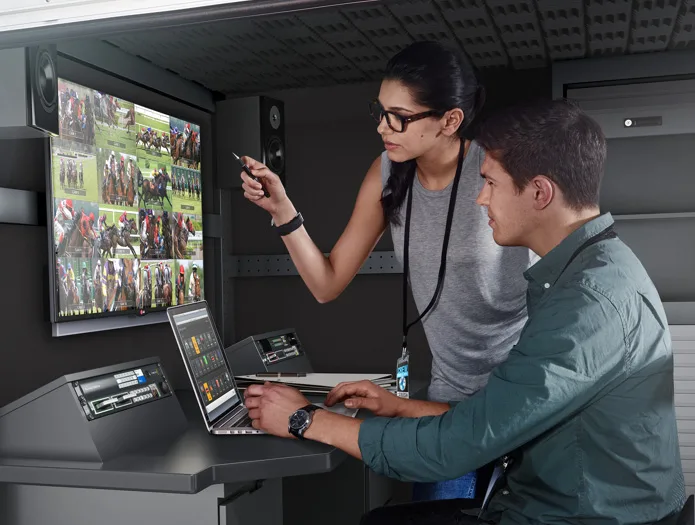6 Trends in Video Post-Production You Need to Know in 2024!

Video production is a rapidly evolving field, constantly influenced by technological advancements and changing audience preferences. As we move into 2024, several key trends are shaping the future of video editing and production.
Staying ahead of these trends is crucial for anyone involved in video creation, from independent filmmakers to large video production companies. Here are six trends in video post-production you need to know to stay relevant and competitive in 2024.
1. Artificial Intelligence and Machine Learning
Artificial Intelligence (AI) and Machine Learning (ML) are revolutionizing video productions. These technologies are being used to automate tedious tasks, enhance creativity, and improve efficiency. AI-powered tools can now handle color grading, audio enhancement, and even editing, allowing editors to focus more on the creative aspects of their projects.
AI algorithms can analyze video content to suggest edits, create automatic captions, and even generate rough cuts. This not only speeds up the post-production process but also ensures a higher level of consistency and quality. As AI technology continues to advance, its role in video production will only grow, making it a trend that cannot be ignored.
2. Remote Collaboration and Cloud-Based Workflows
The shift towards remote work, accelerated by the global pandemic, has significantly impacted video production. In 2024, remote collaboration and cloud-based workflows are becoming the norm. This trend allows video production teams to work together from different locations, enhancing flexibility and accessibility.
Cloud-based platforms enable seamless sharing of large video files, real-time collaboration, and efficient project management. Tools like Adobe Creative Cloud and Frame.io are leading the way, providing robust solutions for remote video post-production. Embracing these technologies ensures that video production companies can maintain productivity and creativity, regardless of physical location.
3. Virtual Reality and Augmented Reality Integration
Virtual Reality (VR) and Augmented Reality (AR) are transforming how we experience video content. In 2024, the integration of VR and AR in video creation is set to become more prevalent. These technologies offer immersive experiences that engage viewers in ways traditional videos cannot.
For instance, VR allows audiences to step into a fully immersive 3D environment, while AR overlays digital elements onto the real world. Video post-production now involves creating and editing these immersive experiences, requiring new skills and tools. As VR and AR content becomes more mainstream, staying updated with these technologies will be essential for video editors and production companies.
4. High Dynamic Range (HDR) and 8K Resolution
High Dynamic Range (HDR) and 8K resolution are pushing the boundaries of video quality. HDR enhances the contrast and color range of videos, resulting in more vibrant and realistic images. On the other hand, 8K resolution offers incredibly detailed and sharp visuals, providing an unparalleled viewing experience.
As consumer demand for higher quality content grows, adopting HDR and 8K resolution in video production is becoming increasingly important. While these technologies require more powerful hardware and larger storage capacities, the investment is worth it for the enhanced visual impact they provide. Video production companies that leverage HDR and 8K can deliver cutting-edge content that stands out in a competitive market.
5. Motion Graphics and Animation
The use of motion graphics and animation in video post-production is on the rise. These elements can add a dynamic and engaging layer to video content, making it more captivating for viewers. From animated logos and text to complex visual effects, motion graphics can enhance storytelling and convey information more effectively.
Advancements in software like Adobe After Effects and Cinema 4D have made it easier to create sophisticated motion graphics and animations. For video production companies, incorporating these elements into their projects can differentiate their content and attract a wider audience. As motion graphics become more prevalent, mastering these skills will be crucial for staying competitive in the industry.
6. Real-Time Rendering and Editing
Real-time rendering and editing are game-changers in video creations. This technology allows editors to see changes in real time, significantly speeding up the editing process and improving workflow efficiency. Real-time rendering eliminates the need for lengthy rendering times, enabling quicker revisions and more creative experimentation.
Tools like Unreal Engine and DaVinci Resolve are at the forefront of this trend, offering real-time capabilities that enhance the editing experience. For video production companies, adopting real-time rendering and editing tools can lead to faster project turnaround times and higher-quality output. This trend is set to become a standard practice in video post-production, making it essential to stay updated with the latest software and techniques.
Also read : Creating Realistic Characters in 3D Animation
Final Thoughts
The video post-production landscape is continuously evolving, driven by technological advancements and changing consumer preferences. In 2024, trends like AI and machine learning, remote collaboration, VR and AR integration, HDR and 8K resolution, motion graphics, and real-time rendering are shaping the future of the industry.
For video editors and video production companies, staying ahead of these trends is crucial to delivering high-quality, innovative content. By embracing these technologies and techniques, you can enhance your post-production workflow, create more engaging videos, and remain competitive in a rapidly changing market.



